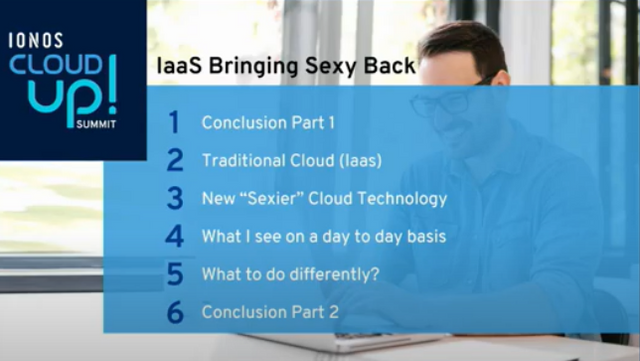How to make workplace tech inclusive for an ageing workforce
While experienced workers don’t need tech handholding, your business can yet streamline its IT to render it more accessible


The UK's workforce is getting older, and, for employers, that means greater access to a wealth of experienced employees. The ONS' latest Living Longer report, for example, reveals the proportion of UK workers over 50 is rising, many of who are less inclined to retire. Businesses, however, might risk losing these valuable members of the workforce by forcing them to use digital tools that are rushed out, inaccessible, and potentially bamboozling.
RELATED RESOURCE

Shining light on new 'cool' cloud technologies and their drawbacks
IONOS Cloud Up! Summit, Cloud Technology Session with Russell Barley
The value of an ageing workforce is clear, with nearly eight in ten (76%) employers suggesting older workers' experience is "crucial to the success of the organisation", according to research by YouGov and the Centre for Ageing Better. The Organisation for Economic Co-operation and Development (OECD), meanwhile, calculates that age-diverse workforces will boost GDP per capita by almost 19% over the next three decades. Anecdotally, too, employers say older workers have adapted particularly well to the home-working shift triggered by COVID-19. They do fear, however, that these gains may be compromised by the rush to roll out hybrid working technologies that have been designed with anyone but the end-user in mind.
"We had ten years of digital transformation thrown at us in 90 days at the start of the pandemic," director of talent and transformation at Advanced, Nick Gallimore, tells IT Pro. "That overwhelmed a lot of us, and it's fair to say there were generational differences in that."
Not all older workers are technophobes, of course. Plenty of IT professionals who grew up with Andy Pandy on TV are now using their decades of insight to spot crucial patterns in cyber security, detect AI biases that younger staff may miss, and help train their colleagues. There's also a significant cohort of over-50s who, unlike Generation Z, are somewhat alienated by phones that double as smart communications hubs, and who struggle with the plethora of devices and software required for modern working.
Don't forget about UX when rolling out new tools
Experience and people skills are vital resources, argues Freeform Dynamics analyst Tony Lock, who began his coding career in the early 1980s. Lock cites retail and education as two major sectors in which older workers have much to offer, and are willing to use digital tools that help them do their jobs better, especially amid social distancing measures. He warns that developers and vendors, however, are often rushing out these tools to the detriment of the overall user experience (UX).
"The tech that people have been offered, particularly for teachers in the rush to teach from home, hasn't been properly tested with users," he says, adding that ease-of-use is often overlooked. "Half the vendor briefings I go on say we've updated our user interface (UI) to make it friendlier and easier to use, but very few do that in-depth research to find out what would make it better for the people who use it." COVID-19 compounded the rush, but usability oversights are nothing new, he continues. "Years ago, Microsoft started claiming their technology was so 'foolproof' that you didn't need to train people to use it. Total nonsense. It's still total nonsense."
If companies fail to invest in accessible digital tools, they won't get the best out of their age-diverse teams, cautions Gallimore. "Level of tech-savvy is absolutely a factor," he says. "When things don't work the way you want them to, especially when you're working from home, that really impacts on people's productivity."
Get the ITPro daily newsletter
Sign up today and you will receive a free copy of our Future Focus 2025 report - the leading guidance on AI, cybersecurity and other IT challenges as per 700+ senior executives
Keeping things simple should be your number one goal
The different strands that comprise workplace tech have become increasingly messy and difficult to manage amid the shift to home-working. Suddenly, organisations are expecting their workers to juggle different digital tools for booking, communication, payments, scheduling, and more. This hasn't just made things difficult for less tech-confident workers – it's also bad for security.
"Organisations that get technology right will get much more benefit from a diverse workforce, which includes a range of ages," says Sarah Henry of Oracle's HR transformation team. "But, instead, they wrap around all these security layers, like you've got to use a VPN then you've got to do a two-factor and make it all really complicated. It just turns people off. Particularly the older generation, who may say I don't understand why I'm doing all this."
Users who struggle with security layers have less time and energy to get on with their jobs, and they can make mistakes, which leave your business vulnerable to attacks. So while it may seem counterintuitive, stripping away layers of security may actually make companies safer.
Gallimore suggests, instead, using a unified authentication solution, much like a password manager. "You can't have this situation where, if you don't understand a particular one of multiple steps, you can't get into the system. Get as much of your employee-facing infrastructure as possible in the cloud, so you can then unify authentication. That would be a huge accessibility boost."
Lock, meanwhile, wants to see virtual workspaces that give workers a customisable dashboard with only the apps they need to do their jobs, while the company controls security and software centrally, and sorts out IT problems remotely. "If your employee does then mess something up on the machine, you just reload it from the centre again," says Lock. "You don't have to send Tony out in his non-eco car to drive 70 miles to fix it."
Some workplace tech vendors have launched products that get close to this unified, easy-to-use ideal. Salesforce's Work.com, for example, platform prioritises health and wellness for employees alongside training, scheduling, and integration with apps such as Slack. Oracle's new HR platform Journeys too, controls security remotely and intelligently, for example by setting different automatic levels of access in different locations. Workday's workspaces, finally, are more aimed at enterprise management, but the platform offers 24/7 support and unified resources that less tech-confident employees will welcome.
We have to be careful not to assume all older workers simply need more tech hand-holding than younger workers. Most certainly don't. The majority of experts, however, agree that if you want an age-diverse workforce, with all the benefits it brings, you have to provide them with digital interfaces that help them perform their jobs, rather than oversaturating them with devices and software that get in the way.
Jane Hoskyn has been a journalist for over 25 years, with bylines in Men's Health, the Mail on Sunday, BBC Radio and more. In between freelancing, her roles have included features editor for Computeractive and technology editor for Broadcast, and she was named IPC Media Commissioning Editor of the Year for her work at Web User. Today, she specialises in writing features about user experience (UX), security and accessibility in B2B and consumer tech. You can follow Jane's personal Twitter account at @janeskyn.
-
 Cleo attack victim list grows as Hertz confirms customer data stolen
Cleo attack victim list grows as Hertz confirms customer data stolenNews Hertz has confirmed it suffered a data breach as a result of the Cleo zero-day vulnerability in late 2024, with the car rental giant warning that customer data was stolen.
By Ross Kelly
-
 Lateral moves in tech: Why leaders should support employee mobility
Lateral moves in tech: Why leaders should support employee mobilityIn-depth Encouraging staff to switch roles can have long-term benefits for skills in the tech sector
By Keri Allan
-
 'Digital hide-and-seek': Workers are wasting hundreds of hours a year sourcing the information they need to carry out their role
'Digital hide-and-seek': Workers are wasting hundreds of hours a year sourcing the information they need to carry out their roleNews Knowledge workers globally are wasting a quarter of their working week tracking down information, new research from Atlassian has revealed.
By George Fitzmaurice
-
 Untethered: How CIOs and CISOs are paving the way for the new hybrid workforce
Untethered: How CIOs and CISOs are paving the way for the new hybrid workforceWhitepaper Effective techniques to transition from exposed legacy infrastructure to an effective zero trust strategy
By ITPro
-
 Unlocking the power of your digital services
Unlocking the power of your digital servicesSponsored Businesses have invested significant cash into technology since COVID-19, but are they really getting their money's worth?
By ITPro
-
 Delivering fast and secure digital experiences for the modern hybrid workforce
Delivering fast and secure digital experiences for the modern hybrid workforceWhitepaper A new approach to digital experience monitoring that can monitor the health of all systems
By ITPro
-
 Collaboration is the glue that holds your business together
Collaboration is the glue that holds your business togetherSPONSORED A combination of productivity tools and cloud telephony can enable the best from your workforce
By ITPro
-
 The future of work and the forgotten workforce
The future of work and the forgotten workforcewhitepaper How to deploy a mobile-first strategy so no one gets left behind
By ITPro
-
 The case for an accelerated device refresh cycle
The case for an accelerated device refresh cycleWhitepaper Achieving a more cost-effective device lifecycle overall
By ITPro
-
 Employees are choosing how they work
Employees are choosing how they workWhitepaper And with the right secure digital strategy, this could be a great thing for your business: today and far into the future
By ITPro